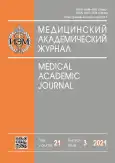Impact of amino acid substitution T203I in hemagglutinin on growth characteristics in vitro and hemagglutinin thermostability of A/H3N2 influenza viruses
- Authors: Bazhenova E.A.1, Stepanova E.A.1, Kotomina T.S.1, Larionova N.V.1, Kiseleva I.V.1, Rudenko L.G.1
-
Affiliations:
- Institute of Experimental Medicine
- Issue: Vol 21, No 3 (2021)
- Pages: 85-90
- Section: Conference proceedings
- URL: https://bakhtiniada.ru/MAJ/article/view/77767
- DOI: https://doi.org/10.17816/MAJ77767
- ID: 77767
Cite item
Abstract
Background: Russian live attenuated influenza vaccines are a three-component preparations that contain vaccine strains based on current epidemic influenza A/H1N1, A/H3N2 and B strains. Recent influenza viruses A/H3N2 are most susceptible to drift antigenic changes, and therefore, this component of the live attenuated influenza vaccines must be constantly updated. Current vaccine strains of live attenuated influenza vaccines are obtained by the method of classical reassortment using selective factors in developing chicken embryos. During the process of preparation of live attenuated influenza vaccines strains, single reassortants can acquire various egg-adaptive amino acid substitutions in hemagglutinin and neuraminidase – the genes responsible for the antigenic correspondence of the vaccine strain to the epidemic parent. These amino acid substitutions can affect the biological properties of the vaccine strain, thereby reducing the effectiveness of this component of live attenuated influenza vaccines.
AIM: The aim of the study was to explore the effect of amino acid substitution T203I in hemagglutinin of A/H3N2 influenza viruses on growth characteristics and hemagglutinin thermostability.
MATERIALS AND METHODS: For the study, three pairs of A/H3N2 vaccine reassortants were prepared. Reassortants differed from each other by amino acid Thr or Ile at position 203 in the hemagglutinin. The growth properties of vaccine strains were assessed by titration in eggs at 26–40°C and in a MDCK cell culture at 33°C. The thermostability of the hemagglutinin of studied influenza viruses was assessed by determining their ability to agglutinate 1% erythrocytes after exposure to elevated temperatures in the range of 37–70°C.
RESULTS: The amino acid substitution T203I in hemagglutinin in reassortants obtained on the basis of current influenza A/H3N2 viruses acquired during the preparation of vaccine strains does not affect the temperature sensitivity of viruses. It was shown that viruses with an egg-adaptive substitution T203I in hemagglutinin have more pronounced cold-adapted phenotype and a higher reproductive activity in MDCK cell culture, compared to strains without this mutation. It was found that hemagglutinin of reassortants with 203 Ile is more thermostable than with 203 Thr.
CONCLUSIONS: Our data indicate that the amino acid substitution of T203I in hemagglutinin in current influenza A/H3N2 viruses does not have a negative effect on biological properties, but improves growth characteristics in eggs and MDCK cells, as well as the thermostability of viruses.
Full Text
##article.viewOnOriginalSite##About the authors
Ekaterina A. Bazhenova
Institute of Experimental Medicine
Author for correspondence.
Email: sonya.01.08@mail.ru
ORCID iD: 0000-0003-3280-556X
Cand. Sci. (Biol.), Senior Researcher
Russian Federation, Saint PetersburgEkaterina A. Stepanova
Institute of Experimental Medicine
Email: fedorova.iem@gmail.com
ORCID iD: 0000-0002-8670-8645
SPIN-code: 8010-3047
Cand. Sci. (Biol.), Senior Researcher
Russian Federation, Saint PetersburgTatiana S. Kotomina
Institute of Experimental Medicine
Email: tstretiak@gmail.com
ORCID iD: 0000-0001-9999-089X
SPIN-code: 7613-9715
Researcher
Russian Federation, Saint PetersburgNataliya V. Larionova
Institute of Experimental Medicine
Email: nvlarionova@mail.ru
ORCID iD: 0000-0003-1171-3383
SPIN-code: 4709-5010
Dr. Sci. (Biol.), Leading Researcher
Russian Federation, Saint PetersburgIrina V. Kiseleva
Institute of Experimental Medicine
Email: irina.v.kiseleva@mail.ru
ORCID iD: 0000-0002-3892-9873
SPIN-code: 7857-7306
Dr. Sci. (Biol.), Professor, Head of the Laboratory
Russian Federation, Saint PetersburgLarisa G. Rudenko
Institute of Experimental Medicine
Email: vaccine@mail.ru
ORCID iD: 0000-0002-0107-9959
SPIN-code: 4181-1372
Dr. Sci. (Med.), Professor, Honored Scientist of the Russian Federation
Russian Federation, Saint PetersburgReferences
- Wareing MD, Marsh GA, Tannock GA. Preparation and characterization of attenuated cold-adapted influenza A reassortants derived from the A/Leningrad/134/17/57 donor strain. Vaccine. 2002;20(16):2082–2090. doi: 10.1016/s0264-410x(02)00056-7
- Isakova-Sivak I, Chen LM, Matsuoka Y, et al. Genetic bases of the temperature-sensitive phenotype of a master donor virus usedin live attenuated influenza vaccines: A/Leningrad/134/17/57 (H2N2). Virology. 2011;412(2):297–305. doi: 10.1016/j.virol.2011.01.004
- Sanger F, Nicklen S, Coulson AR. DNA sequencing with chain-terminating inhibitors. Proc Natl Acad Sci USA. 1977;74(12):5463–5467. doi: 10.1073/pnas.74.12.5463
- Reed L, Muench H. A simple method of estimating fifty per cent endpoints. American Journal of Epidemiology. 1938;27(3): 493–497. doi: 10.1093/OXFORDJOURNALS.AJE.A118408
- Scholtissek C. Stability of infectious influenza A viruses at low pH and at elevated temperature. Vaccine. 1985;3(3 Suppl): 215–218. doi: 10.1016/0264-410x(85)90109-4
- Imai M, Watanabe T, Hatta M, et al. Experimental adaptation of an influenza H5HA confers respiratory droplet transmission to a reassortant H5HA/H1N1 virus in ferrets. Nature. 2012;486(7403):420–428. doi: 10.1038/nature10831
- Shelton H, Roberts KL, Molesti E, et al. Mutations in haemagglutinin that affect receptor binding and pH stability increase replication of a PR8 influenza virus with H5 HA in the upper respiratory tract of ferrets and may contribute to transmissibility. J Gen Virol. 2013;94(Pt 6):1220–1229. doi: 10.1099/vir.0.050526-0
- Wen F, Li L, Zhao N, et al. A Y161F hemagglutinin substitution increases thermostability and improves yields of 2009 H1N1 influenza A virus in cells. J Virol. 2018;92(2):e01621–17. doi: 10.1128/JVI.01621-17
Supplementary files






